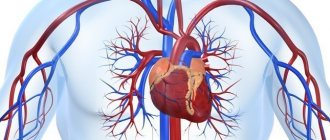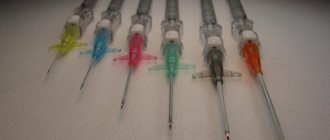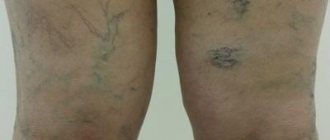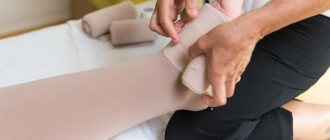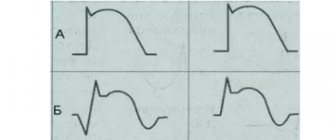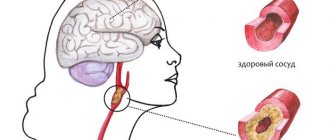There are contraindications. Specialist consultation is required.
Forms of the disease Causes of development Symptoms Who is at risk? Classification What will happen if left untreated? Diagnostics Treatment methods and techniques Prevention
Chronic venous insufficiency, as well as its acute form, is associated with impaired blood flow. Thanks to the valve system, as well as the muscles of the body, blood from the lower extremities flows to the heart, overcoming the force of gravity. Therefore, moderate physical activity, gymnastics during sedentary work, and regular walks are recommended for each person. If, due to an incorrect lifestyle or poor heredity, varicose veins appear or the lumen of the vessel is clogged with a blood clot, venous insufficiency of the legs begins to develop. First, the affected vein expands, then the function of the valves is disrupted (they do not close completely), and the result is reflux, that is, reverse flow of blood - it flows not only to the heart, but also back to the legs. Due to the accumulation of blood, a person feels heaviness in the legs and swelling appears. These symptoms should not be attributed to fatigue; you need to urgently contact a phlebologist, otherwise chronic venous insufficiency will develop.
Important! Varicose veins and venous insufficiency are not the same thing. Varicose veins are only one sign of insufficiency, although the most common.
Forms of venous insufficiency
The course and treatment of venous insufficiency depend on what form of the disease is present in the patient. The SM-Clinic employs some of the best phlebologists in St. Petersburg and has advanced diagnostic equipment. Thanks to this, we provide qualified assistance even at the first symptoms.
Acute venous insufficiency (AVI)
Appears due to a sharp disruption of blood flow in deep-lying vessels. For example, due to blockage of a vein by a blood clot. Also, its causes are the peculiarities of blood clotting, various diseases, and intoxication when taking certain medications.
The disease develops rapidly, its signs are immediately visible: bluish skin, rapid and severe swelling of the legs, and a visually easily noticeable venous pattern. In addition, the person feels pain in the legs. OVN has no stages.
Chronic venous insufficiency (CVI)
It develops slowly, at first it does not even give symptoms, but gradually leads to serious problems. May be a consequence of varicose veins left without treatment. Leads to trophic ulcers and various complications, including infection of the limb.
Has several stages:
- At zero there are no unpleasant symptoms, only spider veins are visible. Unfortunately, people at this stage rarely go to the doctor.
- In the first stage, in the evening a person feels heaviness in his legs and notices swelling. This is caused by small lesions in the superficial veins.
- On the second, pigment spots appear, swelling does not go away after a night's rest, and eczema (its parts) occurs.
- At the third stage, trophic ulcers appear at the site of eczema - weeping, non-healing wounds.
CVI at a high degree of development is accompanied by bleeding, thrombophlebitis, and blockage of deep veins by blood clots.
Blood stasis in the lungs
Venous congestion in the lungs is observed when the heart muscle is insufficient, when the outflow of blood from its left parts is obstructed. Passive venous hyperemia of the lungs develops. Blood fills the capillaries of the lung tissue, increasing the pressure in them. A similar picture can be observed with right ventricular hypertrophy.
The air space of the alveoli is reduced due to the protrusion of capillaries into the alveolar space. Violation of the permeability of the walls of small capillaries leads to the release of fluid into the alveoli and intercellular space.
Venous congestion in the lungs is expressed as an increase in their size and increased tissue density. The patient develops symptoms of increased interpleural pressure, and the suction force of the chest cavity is reduced.
Reduced elasticity of the lung tissue leads to disruption of the drainage function of the lymphatic system. The chronic course causes the proliferation of fibrous tissue and even greater compaction of the lung tissue.
What are the causes of venous insufficiency?
All causes of the disease can be divided into groups:
- Negative heredity. These include structural features of blood vessels, insufficiency of the vascular wall and valve apparatus.
- Blood flow disorders: varicose veins, thrombosis, consequences of injuries, postthrombophlebitis syndrome, constantly high pressure in the lower extremities, phlebitis, pregnancy.
- Lifestyle: obesity, lack of physical activity, excessive strength loads (both uncontrolled lifting of weights in the gym and, for example, working as a loader), sedentary lifestyle or standing work.
- Hormonal status: women suffer from venous insufficiency more often than men, this also includes taking OCs (oral contraceptives) and hormonal therapy.
- Age factor: the older the patient, the higher the likelihood of the disease.
Symptoms of the disease
Let's look at the general symptoms first. It should be remembered that in the initial stages of the disease they appear one at a time and are often “blurred”. The more the disease progresses, the more pronounced the symptoms, and they most often appear in groups. So:
- pain in the legs, feeling of heaviness, fullness;
- spider veins;
- swelling - first passing after rest, then permanent;
- night cramps in the legs;
- dryness, unhealthy shine of the skin, age spots or areas of discoloration;
- trophic ulcers at an advanced stage.
Consultation with a surgeon: when to contact, how is the appointment?
Symptoms of CVI by stage
| Stage | Description |
| 0 | The person is able to work, there are no symptoms, they do not appear after sports and other activities. |
| 1 | Slight pain, heaviness in the legs and swelling at the end of the day, which disappears in the morning, mild cramps. A person is not limited in physical activity and can work at the same pace. |
| 2 | Manifestations of venous insufficiency become pronounced. These are skin pigmentation, dermatological diseases, severe swelling, skin necrosis in some areas. It becomes difficult for a person to work physically or play sports. |
| 3 | Trophic ulcers appear and tissue metabolism is completely disrupted. A person loses his ability to work. |
Symptoms of AHF
Signs of the disease are more pronounced and appear much faster compared to CVI:
- Pain in the legs that increases with movement;
- just below the site of vein blockage there is large swelling;
- difficulties in any physical activity;
- pallor or bluishness of the skin;
- at the site of pathology, skin temperature decreases by 2-3℃;
- body temperature can rise to 40℃;
- increasing pain to unbearable;
- “referring” pain to the groin and pelvis area.
Important! To reduce the likelihood of a blood clot breaking off with subsequent thromboembolism, the patient needs to limit movement. Bed rest is recommended for up to 10 days; the affected leg should be higher than the body.
Signs of violation
When venous outflow is impaired in children, the following signs appear:
- worsening sleep;
- anxiety;
- decreased attention;
- delayed psycho-speech development;
- pronounced venous network on the head
A child with such disorders gets tired quickly and cannot concentrate. Attention is scattered, activity drops. In an adult, disturbances in venous outflow also have a negative impact on sleep, well-being, and activity.
As a child with such problems ages, other symptoms may appear: lack of coordination, emotional instability, convulsions, tremors of the limbs, dizziness, darkening of the eyes, noise and ringing in the ears.
Classification of the disease
Acute venous insufficiency has no classification by stages. Let's consider the degrees and stages of the chronic form of the disease. To fully describe the patient’s diagnosis, doctors use the CEAP classification, that is, assigning a kind of “code”, for example: C4a, S, Eс, Ad, Pr, 8, 10, 11, 17. It is deciphered based on the following classification characteristics.
C – pathology class:
- C0 – no visible symptoms;
- C1 – spider veins;
- C2 – dilated veins from 3 mm;
- C3 – swelling in the areas of the legs and ankles;
- C4a – dermatitis, pigmentation and other skin lesions;
- C4b – increased pigmentation, thickening of the skin;
- C5 – self-healing skin wounds;
- C6 – non-healing trophic ulcers.
The following index indicates whether the patient has complaints: A – without symptoms or complaints, S – there are complaints.
E – cause of disease:
- EC – congenital;
- Er – etiology unknown;
- Es – the reason is known.
A – localization:
- As – saphenous veins;
- Ar - vessels that connect the deep veins and subcutaneous veins;
- Ad – deep veins;
- Аn – there are no pathologies of the venous system.
P – type of pathology:
- Po – cessation of blood movement through the veins;
- Pr – valve insufficiency;
- Pr,o – both;
- Рn – no disturbances in the movement of blood through the veins were detected.
The number is the area of the venous system where the pathology is detected: from 1 to 18.
Treatment of CVI
To treat pathology, a conservative method is used, if possible, and an operative one.
Conservative technique
Such therapy is possible when there are no irreversible changes in the veins. Treatment primarily involves wearing compression garments (knitwear), which creates a frame for the affected veins and prevents them from overstretching. It also increases blood flow through the veins, preventing the formation of blood clots.
Compression knitwear is knee socks, leg warmers, stockings, tights. It varies in compression strength. Selecting the optimal option individually is the task of a phlebologist.
Patients are also advised to lose weight if they are overweight and especially obese. Losing body weight means unloading the veins. When prescribing a diet, attention is also paid to the prevention of constipation in order to prevent constantly increased venous pressure.
The patient must be prescribed therapeutic exercises or exercise therapy. Swimming is especially beneficial.
In addition, drug therapy is carried out with the following types of drugs:
- angioprotectors;
- bioflavonoids;
- anticoagulants;
- local anesthetics;
- glucocorticosteroids.
An additional measure is external agents, that is, heparin-based gels and ointments.
Surgery
Radical method of treating chronic venous insufficiency. Indications for surgery are severe symptoms, pathological reflux, progression of trophic ulcers, low effectiveness of conservative treatment, pronounced progression of CVI.
Basic techniques:
- laser;
- surgical;
- ablative;
- bypass;
- phlebectomy, endoscopic phlebectomy.
Preparing for surgery
The patient undergoes a duplex scanning of the veins, as well as a standard examination, which includes:
- ECG;
- fluorography;
- coagulogram;
- general and biochemical blood tests;
- general urine analysis;
- blood tests for infections, group and Rh factor.
The test results are provided to the therapist. You also need to consult with an anesthesiologist.
Before the procedure, the patient should remove hair from the intended intervention area. The last meal is 4-6 hours before.
Progress of the operation
- Laser technique . Allows you to eliminate varicose veins and significantly enlarged veins. The affected vessel is irradiated from the inside with a laser at high temperature. As a result, its walls “stick together”, and gradually it completely disappears. No incisions are needed - just punctures. The procedure is carried out under ultrasound control.
- Surgery . To access the affected veins, several small incisions are made in the skin and soft tissue. The surgeon either completely removes the damaged vessel or ties the veins that connect the deep and superficial (in the area of the legs). Surgery is performed when the veins are significantly dilated.
- Phlebectomy . Removal of small veins. Several small incisions are made on the skin under local anesthesia, through which the doctor gains access to the affected vessel and removes it.
- Endoscopic phlebectomy . A microcamera is inserted into the vessel, allowing the doctor to remove the affected vein under visual control. The method is applicable when ulcers are present.
- Ablation . A flexible catheter is inserted into the vein. The heating electrodes, which are located at its end, thermally act on the venous wall, destroying it.
- Bypass surgery . An artificial vessel is used that connects the veins so as to allow blood flow to bypass the damaged area. Usually performed with the development of CVI and severe venous damage.
Rehabilitation
In the first days, swelling, hematomas and compactions in the affected area are possible. If stitches were applied, they are removed after 7-10 days.
From 1 to 2 months you need to constantly wear compression garments, and then - for the period recommended by your doctor - only during the day. Also, depending on the type and scale of the intervention, the patient is prescribed medications (primarily painkillers), physiotherapy, and exercise therapy. Walking at a calm pace is recommended.
Overheating of the intervention area and heavy physical activity are completely eliminated for about 2 months. During sleep, your legs should be placed on a slight elevation - about 15 cm.
Consequences of the disease
Phlebologists at the Dynasty Clinic are well aware that our patients face significant difficulties associated with the disease. Judge for yourself:
- maintenance treatment is required, the cost of which increases as the disease progresses;
- stagnation of venous blood negatively affects other diseases, especially heart and lung diseases;
- cosmetic defect - darkening (pigmentation) of the skin of the legs in advanced cases remains persistent and does not go away even with successful restoration of blood flow;
- restrictions on flying, staying in hot climates - choosing a vacation spot can be a problem;
- if complications develop, hospitalization, a long period of disability, surgery, expensive procedures and medications may be required;
- restrictions appear on the choice of profession.
Listen to your doctor's recommendations!
Prevention of venous insufficiency
Preventive measures:
- refusal of high-heeled shoes;
- wearing comfortable clothes that do not constrict the body;
- moderate tan;
- extremely rare visits to the sauna, bathhouse;
- maintaining normal body weight;
- proper nutrition;
- drink plenty of fluids (1.5-2 liters of water, unsweetened tea per day);
- giving up alcohol and smoking;
- active lifestyle;
- regular gymnastics during sedentary or standing work;
- when working sedentarily, place your feet on a not very high stand.
Make an appointment with a phlebologist at SM-Clinic on the website or by phone. Prices for services are indicated on the website.

